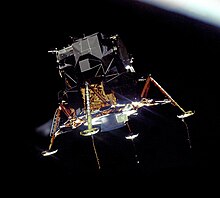Brake rocket
A brake rocket is used to reduce the speed of a spacecraft in order to change its orbit or for a soft landing . Brake rockets do not eject the exhaust gas against it, but in the direction of flight, which slows the spacecraft down or brings it to a standstill.
Brake missiles to leave orbit
By using brake rockets, spacecraft are slowed down enough in orbit to allow reentry and landing. The necessary speed change in a low earth orbit is only about 90 m / s, the remaining speed is reduced by atmospheric friction.
The Mercury and Gemini spacecraft NASA had separate for this purpose braking rockets with solid engines. The four brake rockets of the Gemini spaceship burned 5.5 s each, for a total of 22 s. In contrast to this, the space shuttle , like the Apollo spacecraft in the past, does not use separate brake rockets, but rather the engines intended for orbit corrections. During the Earth orbit missions of the Apollo program , the SPS engine burned for about 12 seconds, while the orbital maneuvering system of the space shuttle burned for about three minutes.
The first use of a brake rocket to leave orbit took place on April 14, 1959 in the return capsule of the reconnaissance satellite Discoverer 2 . However, since the brake rockets were ignited at the wrong time, the return capsule did not drop in the intended target area.
Brake missiles for suborbital flights
In the suborbital test flights of the Mercury program of the NASA also braking rockets were used. This was not absolutely necessary for ballistic flights, but it was an important test for orbital flights. The first use took place on December 19, 1960 on the Mercury-Redstone 1A mission . The two brake rockets of the Mercury capsule burned 10 s each, but staggered by 5 s and reduced the speed by 168 m / s.
Brake rockets during the moon landing
When landing on the moon or another celestial body without an atmosphere, neither parachutes nor atmospheric braking can be used to reduce speed. So the entire orbit speed has to be reduced by braking rockets, which leads to significantly longer burn times and higher fuel consumption. The first successful use of a brake rocket for a soft moon landing was on February 3, 1966 by Luna 9 .
Use of brake rockets shortly before touchdown
In contrast to US spaceships, which touch down on the water or in gliding flight, Russian spaceships land on the mainland. Despite the use of parachutes , the fall speed of the return capsule is still very high. Therefore, shortly before touchdown, further brake rockets are ignited, which further slow down the speed and soften the impact. This system was first used with the Vozhod spacecraft Kosmos 47 and is still used today for Soyuz spacecraft .
Individual evidence
- ↑ Gemini Technical Description in the Encyclopedia Astronautica , accessed on January 3, 2011 (English).
- ↑ Apollo 7 timeline. In: Apollo By The Numbers. NASA, accessed January 3, 2011 .
- ↑ Apollo 9 timeline. In: Apollo By The Numbers. NASA, accessed January 3, 2011 .
- ↑ Landing 101. NASA, November 23, 2007, accessed January 3, 2011 .
- ↑ Discoverer 2 in the NSSDCA Master Catalog , accessed January 4, 2011. "Discoverer 2 was the first satellite ... to send its reentry vehicle back to earth"
- ↑ Soyuz undocking / Landing timeline. NASA, accessed on January 4, 2011 (English): "Six Soft Landing Engines fire to slow the vehicle's descent rate to 1.5 meters (5 feet) per second just 2.6 feet above the ground."
